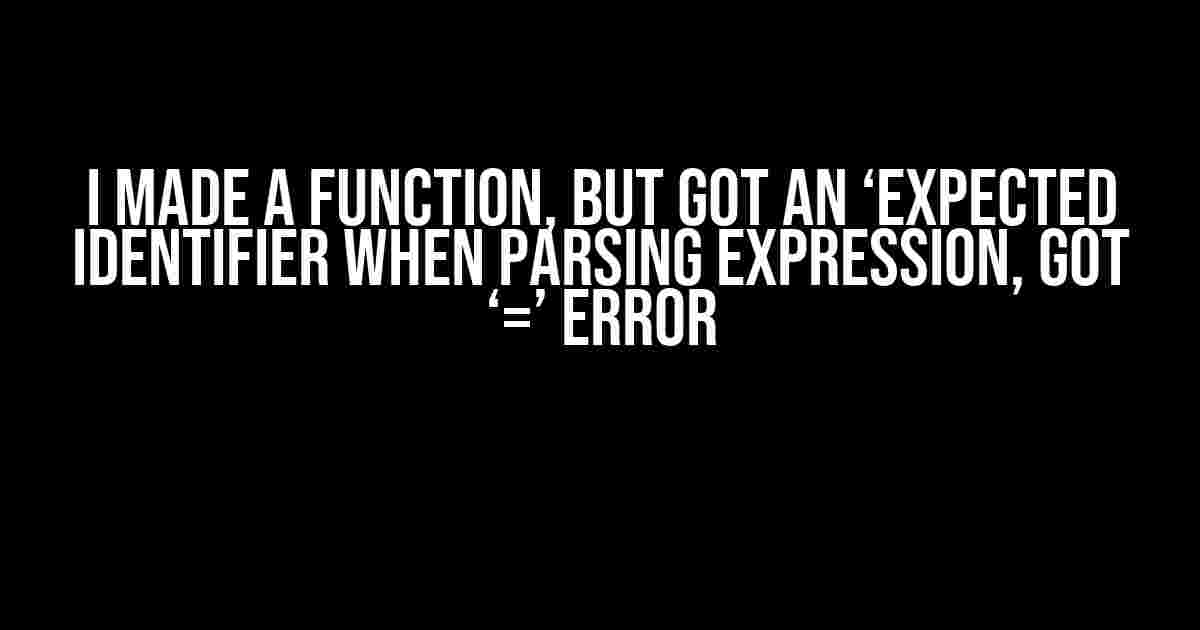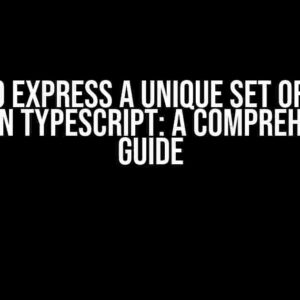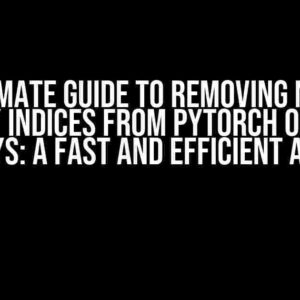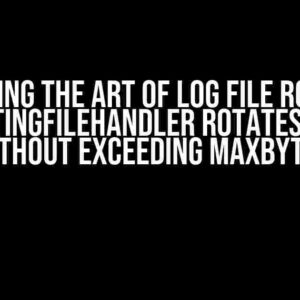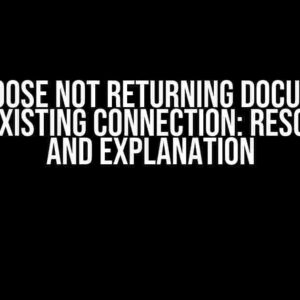Oh no! You’ve encountered one of the most frustrating errors in programming: the “expected identifier when parsing expression, got ‘=’ error”. Don’t worry, friend, you’re not alone. This error has puzzled many a developer, and it’s time to demystify it once and for all.
What’s Causing the Error?
The error message might seem cryptic, but it’s actually trying to tell you something. The parser is expecting an identifier (a variable, function, or property name) but instead, it’s encountering the assignment operator (=). This usually happens when you’re trying to assign a value to something that isn’t a valid identifier.
Common Scenarios That Trigger This Error
Let’s explore some common scenarios that might lead to this error:
-
if (x = 5): You meant to use the comparison operator (==) instead of the assignment operator (=). -
function foo() = { ... }: You can’t assign a value to a function declaration. Remove the (=) and use the function keyword followed by the function body. -
let x = { y = 5 }: You’re trying to use the assignment operator (=) inside an object literal. Use the colon (:) to separate the property name from its value.
Fixing the Error: A Step-by-Step Guide
Now that we’ve identified the common culprits, let’s go through a step-by-step process to fix the error:
-
Read the error message carefully: Take a close look at the error message and identify the line and column numbers where the error is occurring.
-
Check the syntax: Review the code around the error location and ensure that the syntax is correct. Look for misplaced or missing brackets, parentheses, and semicolons.
-
Identify the assignment operator: Find the (=) operator in the code and check if it’s being used correctly. Ask yourself:
- Am I trying to assign a value to a variable or property?
- Am I using the correct operator (e.g., ==, ===, =>)?
-
Replace the assignment operator (if necessary): If you’re using the (=) operator incorrectly, replace it with the correct operator or syntax.
-
Verify the identifier: Ensure that the identifier (variable, function, or property name) is valid and correctly spelled.
-
Test the code: Save the changes and re-run the code to see if the error is resolved.
Real-World Examples and Solutions
Let’s take a closer look at some real-world examples and their solutions:
| Example | Error | Solution |
|---|---|---|
if (x = 5) { ... } |
Expected identifier when parsing expression, got ‘=’ | if (x == 5) { ... } |
function foo() = { ... } |
Expected identifier when parsing expression, got ‘=’ | function foo() { ... } |
let x = { y = 5 } |
Expected identifier when parsing expression, got ‘=’ | let x = { y: 5 } |
Example 1: Incorrect Use of Assignment Operator in an If Statement
<code>
if (x = 5) {
console.log('x is 5');
} else {
console.log('x is not 5');
}
</code>
In this example, the error occurs because the assignment operator (=) is used instead of the comparison operator (==). The corrected code uses the correct operator:
<code>
if (x == 5) {
console.log('x is 5');
} else {
console.log('x is not 5');
}
</code>
Example 2: Incorrect Function Declaration
<code>
function foo() = {
console.log('Hello, world!');
}
</code>
In this example, the error occurs because the assignment operator (=) is used in the function declaration. The corrected code removes the (=) operator:
<code>
function foo() {
console.log('Hello, world!');
}
</code>
Example 3: Incorrect Object Literal
<code>
let x = { y = 5 };
</code>
In this example, the error occurs because the assignment operator (=) is used inside an object literal. The corrected code uses the colon (:) to separate the property name from its value:
<code>
let x = { y: 5 };
</code>
Conclusion
The "expected identifier when parsing expression, got '=' error" might seem frustrating at first, but it's actually a helpful warning sign that something is amiss in your code. By following the steps outlined in this article, you should be able to identify and fix the error, ensuring that your code runs smoothly and efficiently.
Remember, debugging is an essential part of the programming process. Don't be discouraged by errors – use them as an opportunity to learn and grow.
We hope this article has been informative and helpful. If you have any questions or need further clarification, feel free to ask in the comments below!
Happy coding!
Frequently Asked Questions
We've all been there - creating a function, only to be met with that frustrating error message. Don't worry, we've got you covered! Here are the top 5 questions and answers to help you troubleshoot the "expected identifier when parsing expression, got '=' error".
Q1: What does the "expected identifier when parsing expression, got '=' error" mean?
This error typically occurs when the JavaScript parser encounters an unexpected '=' symbol while expecting an identifier. An identifier is a name given to a variable, function, or property. In this case, the parser is telling you that it's not expecting an assignment operator (=) at that specific point in your code.
Q2: How do I identify the problematic code?
To find the problematic code, carefully examine the error message, which usually points to the line and column number where the error occurred. Check that line for any syntax errors, especially around assignment operators (=), function declarations, and variable declarations. You can also try commenting out sections of code to isolate the issue.
Q3: Did I forget to declare a variable?
It's possible! Make sure you've declared all variables before trying to assign a value to them. In JavaScript, you can declare variables using the let, const, or var keywords. Double-check that you've used one of these keywords before the assignment operator (=).
Q4: Could it be a function declaration issue?
Possibly! Function declarations can be tricky. Ensure that you've followed the correct syntax for function declarations. Remember to use the function keyword, followed by the function name, parameters in parentheses, and the function body in curly braces. Also, check that you haven't accidentally used an assignment operator (=) instead of the arrow function syntax (=>) or vice versa.
Q5: What if I've checked everything and still get the error?
Don't worry! It might be time to take a step back and review your code more broadly. Try debugging your code using a tool like Chrome DevTools or a JavaScript linter like ESLint. These tools can help you identify syntax errors and provide more detailed error messages. If you're still stuck, consider sharing your code with a fellow developer or online community for a fresh pair of eyes.

